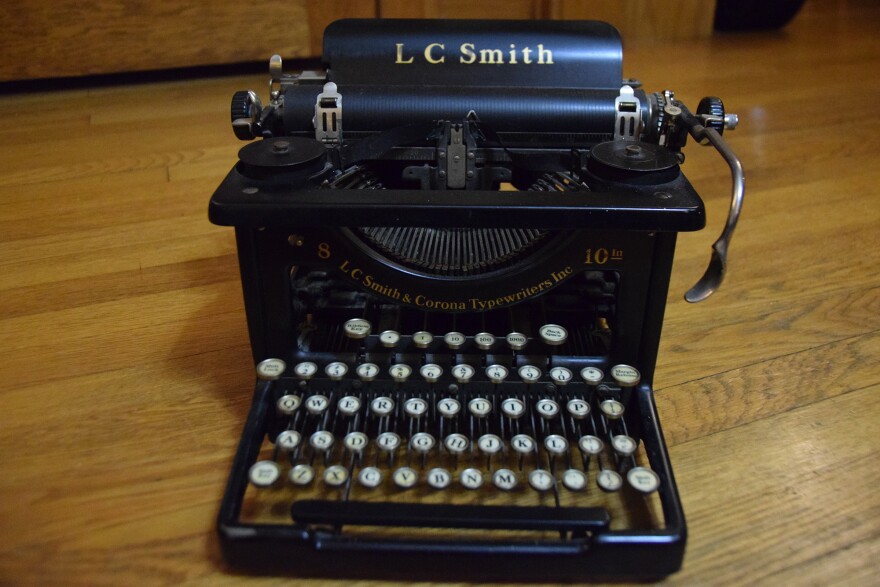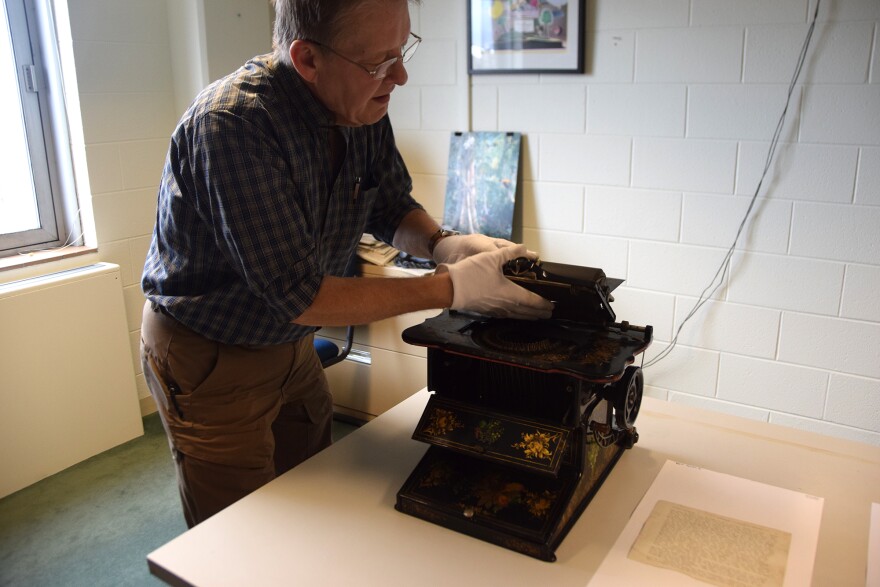Our Bubbler Talk question this week is one after my own heart. Tim Brever in Oak Creek wrote to Bubbler Talk — our series that answers your questions about Milwaukee and the region:
Can you provide more context behind the typewriter being invented in Milwaukee?
Tim doesn’t know it but an Olivetti Studio 44 resides in my office. That was the portable typewriter favored by Tennessee Williams. But I digress.

Tim and others might already know that there’s a historical marker at the corner of Fourth and State Streets that denotes a nearby spot as the birthplace of the typewriter. Today, there aren’t very many typewriters at that spot since it’s now the wreckage of the Bradley Center. But just a half-mile away, at the Milwaukee Public Museum, you’ll find 947 of them.
Al Muchka knows a lot about typewriters — he’s the curator of American history at the Milwaukee Public Museum. There are two in particular he brought out to help describe Milwaukee’s key role in typewriter history.
One of them looks more like a piano keyboard. It was the invention of Christopher Latham Sholes, a newspaper publisher who had been living in what is now Kenosha. It was the mid-19th century, but after studying some other machines, Christopher got some of his fellow tinkerers together at a machine shop on State Street in a very 21st century way.

“They got together and it was kind of like — these days, think of it as a business or invention incubator, you see them all over town — these little places where people get together and they start a business and they really kind of get going with it. And it’s idea after idea after idea,” he explains.

The idea that seems to hold promise is a piano-style keyboard with 38 keys. It was patented in 1868, at which point they immediately set out to improve it, much to the relief of future typists of limited musical talent.
“They started looking further into a lot of this stuff and got the idea of using a telegraph key style keypad to actuate, instead of the piano keys. You got greater action, you were able to have a greater diversity of letters and numbers and characters,” Al says.
But Al says Christopher was an idea man, a dreamer. To scale up production of his new invention, he really needed what a lot of inventors need: a business person.

“He needed somebody with business acumen and he needed some more money. After many, many inquiries were sent by Sholes and his compatriots around the country looking for investors, Densmore answered. And Densmore put up every penny he had,” says Al.
That’s Pennsylvanian James Densmore, a former newspaper associate of Christopher’s. And “every penny” amounted to around $700. But with the money Christopher wanted came something that he was less excited about: advice.

“He invested, gave Sholes the money but then immediately started making suggestions to make it better. And Sholes responded well the first few times. After that, he started getting a little upset with the suggestions,” says Al.
Turns out, a couple of those suggestions were pretty useful. Like, say, the arrangement of the keyboard. After some prompting, Christopher developed the QWERTY keyboard — the keyboard we’re all familiar with. But where did that come from?

“That’s still a little mysterious,” says Richard Polt, a philosophy professor at Xavier University and author of the book The Typewriter Revolution: A Typist's Companion for the 21st Century.
Richard owns about 300 typewriters, by the way, including an original Sholes and Glidden. But again, I digress. He says there are different theories about the origins of QWERTY, but there’s one standard theory.
“To me, it looks like [Christopher] began with an alphabetical keyboard. And you can still see that in the sequence "D F G H J K L," [on the keyboard] but some of the type bars that were swinging up to make the impression were clashing with each other, so he apparently tried to separate commonly used pairs of type bars — for example, T H — so that they wouldn't be too close to each other and wouldn't get stuck,” says Richard.

The other development James Densmore pushes is to sell him more stake in the company. That way he can pursue new financing, which he does in what you might call rapid-fire fashion, signing on the Remington Arms factory.
“They had experience building guns, of course, but then after the Civil War, they needed new products. They've been making things like sewing machines, and so they decided to take a chance and build this thing called the typewriter,” says Richard.
Of the 947 typewriters in the Milwaukee Public Museum’s collection, only one is the focus of the display. Al Muchka describes it as “kind of a jewel situation for one of the Sholes and Glidden machines.”
Have a question you'd like WUWM to answer? Submit your query below.
_






